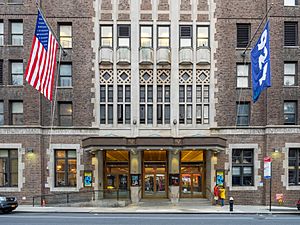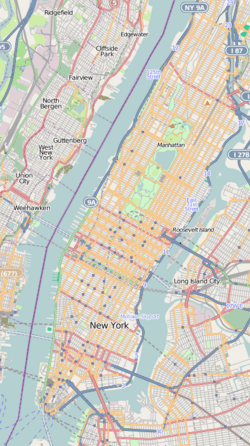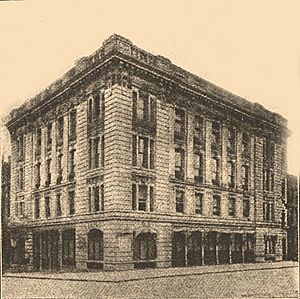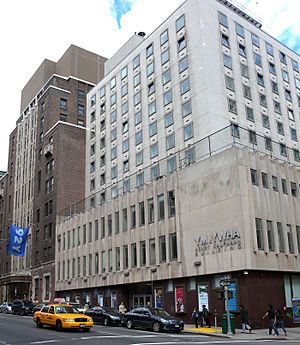92nd Street Y facts for kids

Main entrance to 92NY, 2019
|
|
| Location | 1395 Lexington Avenue, Manhattan, New York |
|---|---|
| Coordinates | 40°46′59″N 73°57′10″W / 40.7830°N 73.9527°W |
| Type | Performing-arts center, YM-YWHA |
| Opened | 1874 (original location) |
The 92nd Street Y, New York (also known as 92NY) is a famous cultural and community center. It is located in the Carnegie Hill area of the Upper East Side in Manhattan, New York City. You can find it at the corner of East 92nd Street and Lexington Avenue. It started in 1874 as the Young Men's Hebrew Association. Over time, it grew from a social club into a large center for arts and culture. People often just call it "the Y."
Contents
The Y's Early History
In 1874, a group of German-Jewish professionals created the New York Young Men's Hebrew Association (YMHA). Many of the founders were part of the Temple Shaaray Tefila, a synagogue. The YMHA was a non-religious group. Its goal was to be a social and literary club for young men.
The YMHA officially started on September 10, 1874. It first operated from rented spaces. Later, it moved to bigger locations. It even had a downtown branch where Emma Lazarus taught English to immigrants. This branch later joined with other groups to become the Educational Alliance.
Growing with Jewish Culture
As the organization grew, it began to include more Jewish traditions. In 1878, the YMHA held its first Hannakuh Festival. This became a yearly event. Celebrating Jewish holidays like Hannakuh and Purim helped keep these traditions alive. It also helped create a unique American Jewish identity.
Regular Friday evening services began in 1900. These services became very popular. Even with these religious activities, other non-religious events remained more popular.
In 1886, the YMHA moved again. It found a permanent home thanks to a generous businessman named Jacob Schiff. Mr. Schiff first gave a house to the Y. Then, he paid for a brand new building at 92nd Street and Lexington Avenue. This new building opened in 1900. It was designed by Arnold W. Brunner, who also designed many synagogues. The original YMHA building was later replaced by an even newer one in 1930.
Expanding Arts and Community
Until the mid-1930s, the YMHA mainly served Jewish people. The Y's director, William Kolodney, believed that the arts were very important. He thought learning for the sake of learning was a key Jewish value. He opened the Y's concert hall and events to everyone, not just members. The hall had great sound, which made the Y famous for performing arts.
During the 1930s, the Y opened many new centers. These included an arts center, a jewelry center, a dance center, a poetry center, and a nursery school. In 1945, the YMHA joined with the Young Women's Hebrew Association. It then became known as the YM-YWHA.
In the 1960s, the Clara de Hirsch Home for Working Girls joined the Y. A new building was built to house it. This new building also created more space for programs and arts. In 1972, the YM-YWHA changed its name to the 92nd Street Y.
Modern Challenges and Growth
In 1988, Sol Adler became the executive director. In the 1990s, the Y faced financial challenges. It responded by adding more classes and expanding its offerings. By 2003, the Y's budget had grown significantly. It served 300,000 people each year.
After the September 11th attacks, the Y explored opening a new location downtown. This led to 92YTribeca, a performance space that opened in 2008. It had a movie theater, lecture hall, cafe, and art gallery. However, the 92YTribeca location closed in 2013.
In 2013, there were changes in leadership at the Y. Henry Timms became the new executive director. He was the first non-Jewish director in the Y's history. To address this, the Y created a new role for a director of Jewish community. While at the Y, Henry Timms helped create Giving Tuesday.
Henry Timms left the Y in 2019. Seth Pinsky became the new head in January 2020. He was chosen to help update the Y's facilities. Soon after, the COVID-19 pandemic greatly affected the institution. Most of its income came from in-person events. The Y quickly started streaming events and classes online. This helped them reach a global audience.
In 2022, the Y changed its name again to 92nd Street Y, New York (92NY). It reorganized its programs and launched an online learning platform called Roundtable. This rebranding came before a big fundraising campaign to renovate its buildings.
In October 2023, the poetry center postponed its reading series. This happened after the Y canceled an appearance by writer Viet Thanh Nguyen. The Y stated this was due to his "public comments on Israel." This cancellation led to some staff members resigning and many speakers canceling their events.
What You Can Do at 92NY
92NY offers many different programs and activities. These include:
- Performing Arts: You can enjoy classical, jazz, and popular music concerts. There are also dance performances.
- Talks and Readings: The Y hosts talks and conversations with interesting people. They also have literary readings and film screenings.
- Learning for All Ages: There are adult education classes. They also have schools for music, art, and dance for both children and adults.
- Family and Kids Programs: You can find activities for families, parenting classes, and programs for children. There's also a nursery school and summer camps.
- Fitness and Wellness: The Y has a fitness center with classes and a swim team.
- Community and Outreach: They offer Jewish education, cultural, and community programs. They also have educational programs for public school children.
About 300,000 people use the Y's facilities in New York each year.
Digital Programs and Giving Back
In recent years, 92NY has added many digital programs. They offer live webcasts of events. They also have a free online archive at 92YOnDemand.org. This archive includes both stage events and online-only content.
In 2012, 92NY started #GivingTuesday. This made the Tuesday after Thanksgiving a day to celebrate and encourage giving. This idea was inspired by the Jewish value of Tikkun olam, which means "repairing the world." It shows the Y's goal of building community and giving back.
92NY is also a founding partner of the annual Social Good Summit. This is a conference that brings together leaders from non-profit groups, tech companies, and businesses. It happens in September during UN Week.
Different Centers at 92NY
92nd Street Y has eight main programming centers:
- Bronfman Center for Jewish Life
- Lillian & Sol Goldman Family Center for Youth & Family
- May Center for Health, Fitness & Sport
- Milstein/Rosenthal Center for Media & Technology
- School of the Arts
- Charles Simon Center for Adult Life & Learning
- Tisch Center for the Arts
- Center for Educational Outreach and Center for Innovation and Social Impact
In 1935, William Kolodney became the Educational Director. He started many educational programs for everyone. He made the "Y" a key place for chamber music, poetry readings, and dance. He also started the Y's dance center, School of Music, and poetry center. The poetry center is now called the Unterberg Poetry Center. Famous writers, like American poet Karl Kirchwey, have led it.
Belfer Center for Innovation & Social Impact
The Belfer Center for Innovation & Social Impact helps share the mission of 92nd Street Y with the world. They work with many partners. These include the UN Foundation, Mashable, Hoover Institution at Stanford University, Harvard Kennedy School, and the Bill and Melinda Gates Foundation.
Famous People at 92NY
Many well-known people have visited or performed at 92NY. Here are some of them:
- Alvin Ailey American Dance Theater
- Al Pacino
- Aziz Ansari
- Alan Dershowitz
- Alec Baldwin
- Stephen Breyer
- Bo Burnham
- Richard Dawkins
- Tom Ford
- Ruth Bader Ginsburg
- Malcolm Gladwell
- Ira Glass
- Lewis Hamilton
- Don Henley
- Christopher Hitchens
- Billy Joel
- Karl Kirchwey
- Chaim Koppelman
- Ralph Macchio
- Rachel Maddow
- Paul McCartney
- Nas
- Jimmy Page
- Colin Quinn
- Jason Segel
- Joan Rivers
- Jon Stewart
- George St. Geegland and Gil Faizon (characters from The Oh, Hello Show)
- Neil deGrasse Tyson
- Elie Wiesel
- Gene Wilder
- Bob Woodward
People Who Lived There
Some notable people have also lived at the 92nd Street Y. Joseph Gurwin (1920–2009), a generous giver, rented a room there for four years. This was after he first came to the U.S. The famous pianist Harry Connick Jr. lived there when he was 18. This was in 1985, when he first moved to New York.






